Think of customer engagement as the ongoing conversation between a shopper and a brand. It’s the emotional connection that builds with every single interaction-from a casual scroll on your website to a chat with a sales associate in-store.
This connection is what turns a one-time purchase into a lasting relationship, transforming casual buyers into your biggest fans.
What Is Customer Engagement in Retail
Let's paint a picture. One retailer shouts generic sales announcements into the void-it's a monologue. Another retailer starts a conversation. They listen to feedback, remember what you like, and send offers that actually make sense for you.
That second scenario? That's modern customer engagement in retail. It’s the big shift from just pushing products to creating genuine, memorable experiences.
This conversation isn't limited to one place. It happens everywhere: in an email, a social media comment, a quick question in your physical store. Every single one of these moments is a chance to either strengthen that bond or weaken it. Get it right, and customers feel seen, understood, and valued. That’s the secret sauce for building relationships that last.
The Shift From Service to Experience
For years, "customer service" was the name of the game. It was all about reacting-fixing problems after they happened. Today, the focus has flipped to proactive engagement. The goal now is to anticipate what customers need and create positive experiences that stop problems from ever starting.
Why the change? Fierce competition and savvy consumers who expect more than just a transaction. They want to feel connected.
The industry is scrambling to keep up. A massive 88% of consumer product marketers are looking to overhaul their approach to engagement, and 85% admit they need to adapt faster than ever. But there's a roadblock: only 35% are successfully sharing customer data across departments. You can dive deeper into this research on evolving customer behaviors from Emarsys.
Core Pillars of Modern Engagement
So, how do you build these powerful relationships? It comes down to a few key pillars that work together to create a journey that feels smooth, personal, and worthwhile.
- Personalization: This is way more than just using someone's first name in an email. True personalization means using data to offer spot-on product recommendations, custom promotions, and content that speaks directly to their past purchases and interests.
- Seamless Omnichannel Journeys: People shop everywhere now-on apps, websites, social media, and in person. A great engagement strategy makes sure that experience is completely seamless. A customer should be able to start browsing on their phone and finish the purchase in your store without a single hiccup.
- Genuine Value Exchange: Engagement is a two-way street. Customers will gladly share their data and their loyalty, but only if they get real value back. This could be exclusive discounts, early access to new collections, or helpful tips that make their lives better. This exchange is the foundation of any good customer loyalty strategy.
Why Strong Engagement Is Your Greatest Asset

Let's be clear: customer engagement in retail isn't just a trendy marketing buzzword. It's the engine of your business's financial health. Think of it like this-unengaged shoppers might grab a one-off deal, but engaged customers return again and again. They become a reliable, predictable source of revenue.
This connection changes everything. It turns a simple transaction into a meaningful interaction. When shoppers feel seen and appreciated, they stick around. And that loyalty has a real, tangible impact on your bottom line.
Fueling Revenue and Profitability
The most direct win from high engagement? More sales. Engaged customers don't just shop more often; they spend more each time they visit. In fact, research shows that fully engaged customers deliver a 23% premium in profitability and revenue compared to the average shopper.
They’re also far more open to upselling and cross-selling because they trust you. That trust translates directly into higher average order values and contributes to overall in-store sales. If you're looking to get the most out of your physical locations, exploring proven strategies for boosting in-store sales is a smart move.
Engaged customers become your most profitable segment. They buy more, try new products, and are less price-sensitive, creating a stable foundation for predictable revenue growth.
This loyalty acts as a powerful buffer against market shifts and competitor discounts. While other brands are burning cash to attract new, price-obsessed buyers, you're nurturing a base of customers who choose you for the experience, not just the sale.
Driving Higher Customer Lifetime Value
Customer Lifetime Value (CLV) is the total profit you can expect from a single customer over their entire relationship with you. Strong engagement is the rocket fuel that sends this metric soaring.
By focusing on building real connections, you naturally encourage repeat business and slash customer churn.
- Increased Purchase Frequency: Engaged shoppers always have a reason to come back, whether it's for a personalized offer, a new product reveal, or just another great experience.
- Higher Average Spend: As that trust deepens, so does their willingness to explore more of what you offer. This leads to bigger, more frequent purchases.
- Longer Customer Lifespan: A genuine emotional connection makes customers far less likely to jump ship to a competitor, keeping them in your corner for the long haul.
Each of these factors pumps up your CLV, making every customer relationship more valuable over time.
Turning Customers into Brand Ambassadors
This might be the most powerful outcome of all: turning happy shoppers into your biggest fans. These customers do more than just buy from you-they actively tell their friends, family, and followers about your brand.
This kind of word-of-mouth marketing is incredibly effective and basically free. People trust recommendations from friends way more than they trust slick ads. Engaged advocates leave glowing reviews, share positive feedback, and build the social proof your brand needs to grow.
This organic marketing dramatically lowers your Customer Acquisition Cost (CAC) because your best customers are doing the heavy lifting for you. It creates a self-sustaining cycle of growth: you delight your customers, they bring you new ones, and your business thrives.
Building a Seamless Omnichannel Experience
In today's world, a brand isn't just a physical store or a website-it's everything in between. A true omnichannel experience makes a customer's journey feel like one continuous conversation, no matter if they're scrolling your social media feed, browsing on their laptop, or walking through your front door.
Think of it like a "brand passport." A customer's preferences, history, and loyalty status should be recognized and valued at every single stop. This approach removes the bumps in the road and delivers the cohesive, personalized journey that modern shoppers expect, building a much stronger foundation for customer engagement in retail.
Unifying the Customer Journey
The whole point of an omnichannel strategy is to knock down the walls between your different sales and marketing channels. A customer might discover a product on Instagram, research it on your website, add it to their cart from your mobile app, and then pop into your physical store to make the final purchase.
A real omnichannel approach makes this entire process feel totally effortless. Their online cart should be accessible in-store. A sales associate should be able to see their browsing history to offer better recommendations. This level of connection shows you understand their needs and, more importantly, that you respect their time.
The infographic below shows just how customers hop between different channels, underscoring why a unified strategy is so crucial.

The data is pretty clear: while face-to-face interactions are still a powerhouse for engagement, digital channels like chat and social media are massive parts of the overall customer experience.
From Disconnected Channels to a Single Conversation
Making this seamless flow a reality requires a big shift in thinking. Instead of treating your e-commerce site, physical locations, and social media presence as separate buckets, you have to see them as interconnected parts of a single customer experience.
Data is the glue that holds it all together. By integrating your systems-your CRM, point-of-sale (POS), and e-commerce platform-you can build a unified customer profile.
An omnichannel strategy isn't about being on every channel; it's about being connected and consistent across the channels your customers actually use. It puts the customer, not the channel, at the center of the experience.
This 360-degree view lets you anticipate what your customers need. For example, if someone keeps looking at a specific item online but hasn't bought it, you can send them a targeted offer or have an associate mention it the next time they're in your store. It’s this kind of proactive, thoughtful approach that makes customers feel truly understood.
To put this in perspective, let’s compare the old way of thinking with the new.
Single-Channel vs. Omnichannel Customer Engagement
The table below breaks down the stark differences between a siloed, single-channel approach and a connected, omnichannel strategy. It's a shift from forcing customers into your world to meeting them in theirs.
| Feature | Single-Channel Approach | Omnichannel Approach |
|---|---|---|
| Customer View | Fragmented; customer data is trapped in separate channel-specific silos. | Unified; a single customer profile is shared across all channels. |
| Experience | Inconsistent and often jarring; what happens online has no bearing on the in-store trip. | Seamless and consistent; the brand feels the same everywhere. |
| Personalization | Limited and generic; based on isolated interactions within one channel. | Deeply personalized; uses data from all touchpoints to anticipate needs. |
| Business Operations | Channels operate independently, often competing with each other for sales credit. | Integrated and collaborative; all channels work together to serve the customer journey. |
| Customer Effort | High; customers have to repeat information and start over at each touchpoint. | Low; the brand remembers their history, preferences, and context. |
As you can see, the omnichannel approach is designed from the ground up to be customer-centric, leading to a smoother journey and, ultimately, a much stronger business.
The Tangible Benefits of Omnichannel Engagement
Getting omnichannel right isn't just about creating a slick experience; it delivers real, measurable business results. Today's path to purchase is anything but a straight line, with 7 out of 10 retail shoppers using multiple channels to get there.
Retailers who lean into this behavior see huge gains. Companies with strong omnichannel strategies report a 9.5% year-over-year revenue increase, a stark contrast to the 3.4% seen by those with weaker approaches. They also manage to cut their cost per customer contact by 7.5% annually. You can dig deeper into these numbers and other retail trends in this detailed Deloitte report.
Here are the key wins you get from building a connected experience:
- Increased Customer Loyalty: A consistent, frictionless journey makes customers feel seen and valued, giving them every reason to come back.
- Higher Customer Lifetime Value (CLV): By making it easier to shop across every channel, you naturally boost how often people buy and how much they spend.
- Improved Data Collection: Every single interaction becomes a chance to learn more about customer behavior, which fuels even smarter personalization down the line.
A fantastic tool for bridging the gap between digital and physical is a loyalty program that lives on a mobile web application. This lets customers check points, redeem rewards, and get offers effortlessly, whether they're sitting on their couch or standing in your store-making the omnichannel experience feel real.
How to Measure Customer Engagement Effectively

There’s an old saying in business: if you can't measure it, you can't improve it. While a buzzing store and happy shoppers feel great, feelings don’t pay the bills. You need hard data to truly understand the health of your customer engagement in retail.
It's way too easy to get distracted by vanity metrics-things like social media likes or page views. They look impressive on a report but often don't tell you anything meaningful about customer loyalty or spending habits. To make smart moves, you need to track the numbers that actually matter.
Key Metrics for Tracking Engagement
Think of these KPIs as the vital signs of your business. Each one tells you something different about your customers' relationship with your brand. Looking beyond simple sales figures is how you shift from short-term wins to building a business that lasts.
Here are the essential metrics you should have on your dashboard:
- Customer Lifetime Value (CLV): This is the big one. It’s the total profit you can expect from a single customer over their entire relationship with you. A rising CLV is the ultimate proof that your engagement efforts are working, turning first-time buyers into your most valuable assets.
- Repeat Purchase Rate: A simple but incredibly powerful metric. What percentage of your customers come back for a second, third, or fourth purchase? This number is a direct reflection of satisfaction. It shows you their first experience was good enough to earn their trust again.
- Net Promoter Score (NPS): This classic metric cuts right to the chase by asking one simple question: "On a scale of 0-10, how likely are you to recommend us?" It sorts your customers into Promoters (your fans), Passives (the indifferent), and Detractors (the unhappy ones), giving you a clear score for brand advocacy.
Interpreting the Data for Action
Just collecting data isn't enough. The real magic happens when you figure out what the numbers are trying to tell you. Each metric is a clue, and your job is to piece them together to solve the puzzle of what your customers really want.
For example, a low Repeat Purchase Rate could mean your post-purchase experience is lacking or the product didn't quite live up to the hype. That single number tells you where to start digging-maybe it's time to send a feedback survey or beef up your follow-up emails.
Your engagement data is a direct conversation with your customers. A high NPS score is a cheer of approval, while a dropping CLV is a quiet signal that something needs to be fixed before a valued customer walks away.
Likewise, your Net Promoter Score is more than just a number. Dive into the feedback from your Detractors to find and fix the specific pain points that are hurting your brand. On the flip side, you can empower your Promoters by asking them for reviews or inviting them to a referral program. Turn their happiness into your best marketing tool.
Connecting Metrics to Business Outcomes
At the end of the day, measuring customer engagement in retail is all about driving real business results. A solid engagement strategy should lead to clear improvements you can see on your bottom line, from higher sales to lower marketing costs.
Think about these connections:
- High Engagement Drives Revenue: Engaged customers don't just shop more often; they're also less sensitive to price. Studies have shown that creating a personalized shopping experience can boost average order value by 10-15%.
- Loyalty Lowers Acquisition Costs: When your happy customers (your Promoters) start spreading the word, they become your best marketers. This kind of organic, word-of-mouth advertising is incredibly powerful and drastically reduces how much you have to spend to find new customers.
- Data Informs Smarter Operations: By tracking how customers move through your store-which areas they visit most, where they linger-you get incredible insights for store layout and inventory. You can stock what people want, right where they're most likely to see it.
By connecting these dots, you can stop guessing and start making confident, data-backed decisions that build genuine loyalty and drive the kind of sustainable growth every retailer is after.
Using Technology to Personalize at Scale
Making one customer feel special is an art. Making thousands of them feel that way at the same time? That’s a science, and it’s powered by technology. For years, personalization was a manual, often clumsy process. Today, tools like AI and advanced data analytics let retailers craft deeply personal experiences for every single shopper, no matter how big their audience gets.
This isn't just about dropping a customer's first name into an email. It’s about creating a shopping journey that feels like it was designed just for them. Technology acts like a brilliant personal shopper for your entire customer base-remembering preferences, anticipating needs, and offering suggestions that feel genuinely helpful, not just algorithmic. The goal is to move past broad demographic buckets and start having real one-to-one conversations.
This shift is more important than ever as online shopping continues to explode. Global retail eCommerce sales are expected to hit a staggering $7.4 trillion by 2025, making up nearly a quarter of all retail spending. Retailers who can master technology to analyze real-time data will have a massive edge in grabbing the attention of the 2.77 billion digital buyers out there.
The Power of AI and Predictive Analytics
At the heart of modern personalization is Artificial Intelligence (AI). AI engines are incredible at sifting through mountains of customer data-purchase history, browsing behavior, items left in a cart-to spot patterns a human could never see. This allows for incredibly accurate predictions about what a customer might want or need next.
Predictive analytics takes this a step further. Instead of just reacting to what a customer has already done, it forecasts what they’re likely to do. This lets you get ahead of the game, sending a perfectly timed offer for a product they're probably considering or a friendly reminder to restock an item they buy every month.
This is the tech behind many of the features customers now take for granted:
- Tailored Product Recommendations: Suggesting items that actually complement past purchases, not just what's popular this week.
- Dynamic Website Content: Changing up the homepage or promotions based on who is visiting the site.
- Customized Offers: Sending unique discounts on products a specific customer has already shown interest in.
The Central Role of Customer Relationship Management
None of this works without a central hub for all your customer data. That's where a modern Customer Relationship Management (CRM) system comes in. Think of a CRM as the brain of your engagement strategy, collecting and organizing every single interaction a customer has with your brand, no matter where it happens.
Building a true omnichannel strategy means investing in the right tech. An advanced retail customer management software is critical for gathering insights and tailoring every interaction. It gives you a single, unified view of each customer, making sure their experience is consistent and informed, whether they’re shopping on your app or talking to an associate in-store.
Technology’s greatest strength in retail is its ability to remember. It remembers every click, every purchase, and every preference, allowing you to treat every customer like your only customer, every single time.
This unified profile is what makes personalization at scale possible. When your systems are integrated, an in-store associate can see a customer's online wishlist, or an email campaign can be automatically triggered by an in-store purchase. Without that central data hub, your efforts will always feel fragmented and fall flat. Tracking these interactions with powerful analytics is key, and you can learn more about how to leverage analytics and stats to get a clearer picture of your customers.
Bringing Personalization to Life
Let's look at how this all plays out in the real world. Here are a few practical examples of how technology transforms the customer journey, making every touchpoint feel more relevant.
- Predictive In-App Suggestions: A customer who regularly buys running shoes from your app opens it to find a curated list of new arrivals in their preferred brand and size. The app also suggests high-performance socks and hydration gear based on what other runners have bought with those shoes.
- Location-Based Offers: A loyal customer walks past your physical store and their phone buzzes. It's a push notification with a special offer valid only for the next hour. This is made possible by connecting their location data (with permission, of course) to their loyalty profile.
- Proactive Customer Service: An AI-powered chatbot notices a customer has been stuck on the checkout page for a few minutes. It proactively opens a chat window to ask if they have questions about shipping or payment, swooping in to prevent cart abandonment.
In each of these scenarios, technology isn't replacing the human connection-it's making it stronger. By anticipating needs and removing friction, you create an experience that feels effortless and thoughtful. That’s how you forge a powerful connection that builds lasting customer engagement in retail.
Got Questions About Retail Engagement? We’ve Got Answers.
Even the sharpest retail strategy can hit a few snags in the real world. Questions pop up. That’s normal. Here are some of the most common ones we hear from retailers, along with straight-up, practical answers to help you build those crucial customer connections.
What’s the First Step for a Small Business?
Before you even think about fancy software or complex campaigns, start with the people who are already walking through your door (or visiting your site). The best first step is simply to get to know your current customers.
Start small. Gather feedback with simple surveys, strike up conversations at the checkout counter, or run a quick poll on social media. You can even use a basic spreadsheet to track what people buy and what they seem to love. This isn't about big data; it's about paying attention. This early information is gold-it helps you figure out who your best customers are and what truly matters to them, all without needing a massive budget.
How Can I Measure the ROI of My Engagement Efforts?
This is the million-dollar question, isn't it? To see the return on your investment (ROI), you have to connect your engagement efforts directly to your sales numbers. It’s all about linking actions to outcomes.
Focus on a few key metrics: Customer Lifetime Value (CLV), repeat purchase rate, and average order value. The trick is to compare these numbers for your engaged customers versus your unengaged ones.
For example, take a look at the spending habits of people in your loyalty program and stack them up against those who aren't. Is there a difference? You can also track your Net Promoter Score (NPS) to see if happier, more engaged customers are bringing in new business through word-of-mouth. The goal is to draw a clear, undeniable line between higher customer engagement in retail and more money in the bank.
How Is Omnichannel Different From Multichannel?
This one trips a lot of people up, but getting it right is a game-changer for modern retail.
Think of it like this:
- Multichannel is like having separate storefronts. You might have a physical shop, a website, and an Instagram page, but they all operate in their own little bubbles. They don't talk to each other.
- Omnichannel is about creating one single, unified shopping world. All those different channels are connected and work together seamlessly.
An omnichannel experience lets a customer browse your app on their phone, add an item to their cart from their laptop later, and then swing by your physical store to pick it up-all without a single hiccup. The entire journey is designed around their convenience, not your channels.
In short, multichannel is just being in multiple places. Omnichannel is about creating a single, fluid experience across all of them. This connected approach is what builds the kind of loyalty that lasts.
Ready to turn casual shoppers into loyal fans? BonusQR makes it easy for any small business to launch a digital loyalty program that builds genuine customer engagement. Start rewarding your customers and watch your business grow.
